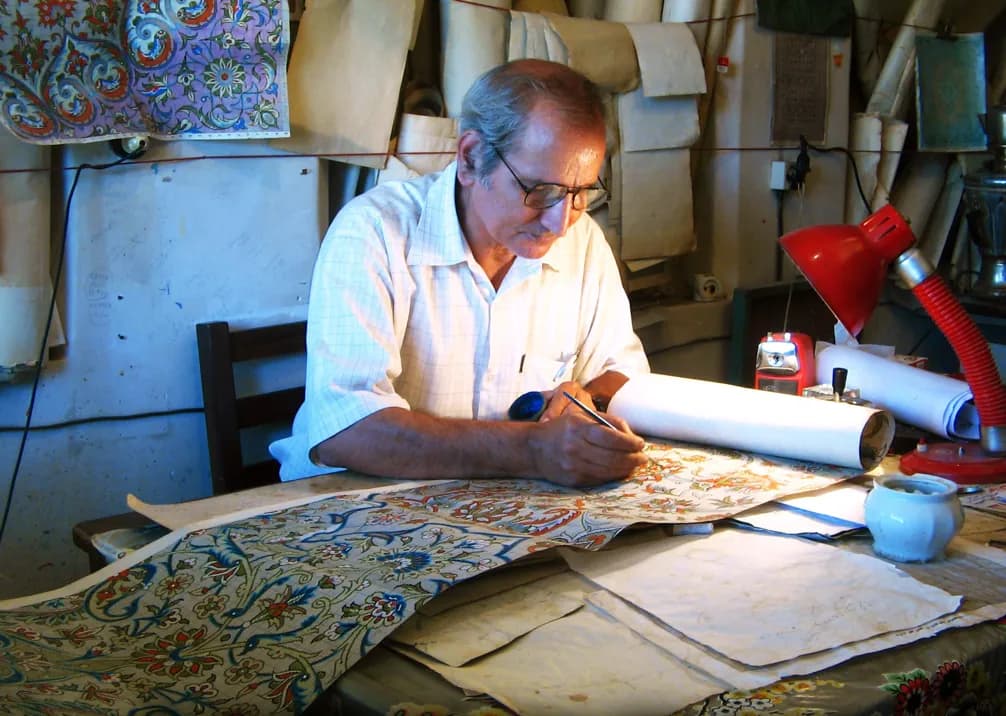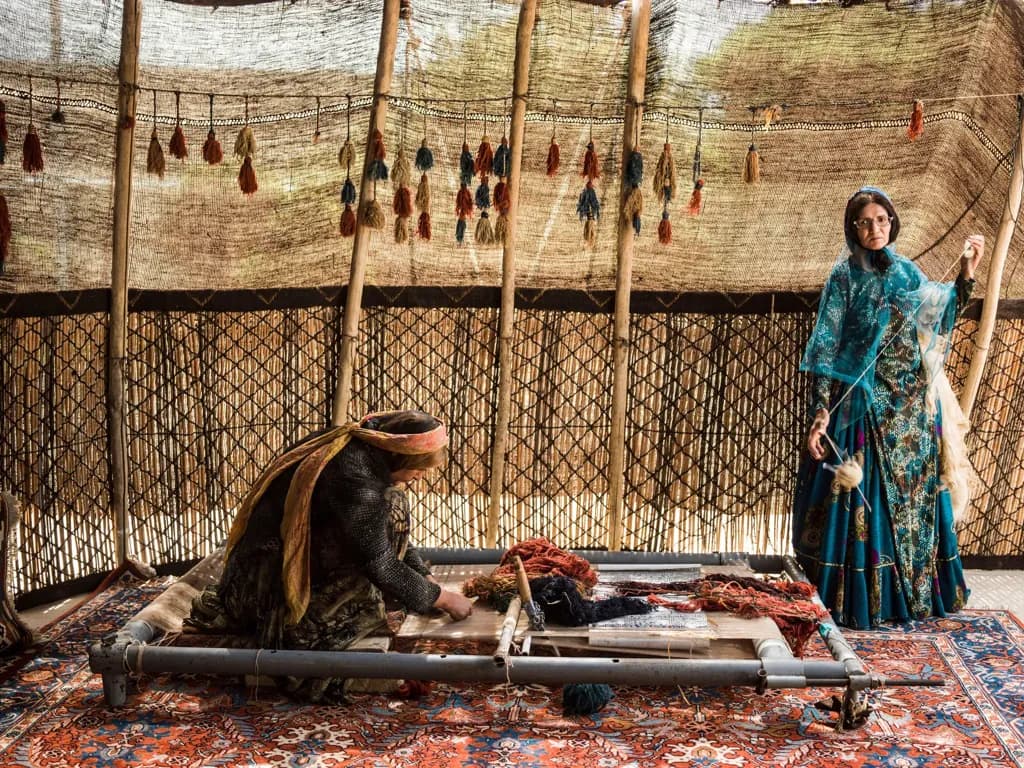BijarPersian rugs from the Kurdish town of Bidjar in northwestern Iran, known as the "Iron Rugs of Persia" due to their exceptional durability and dense weave. Feature intricate floral and geometric designs with a distinctive tight weave that makes them extremely sturdy and long-lasting. rugs, originating from the city of BijarPersian rugs from the Kurdish town of Bidjar in northwestern Iran, known as the "Iron Rugs of Persia" due to their exceptional durability and dense weave. Feature intricate floral and geometric designs with a distinctive tight weave that makes them extremely sturdy and long-lasting. in Iran's Kurdistan province, are renowned worldwide as the Iron Rugs of Iran
due to their exceptional densityA measure of how tightly packed carpet fibers are within the pile. Higher density generally indicates better durability and performance. Calculated by multiplying the face weight by 36 and dividing by the pile height. and durability. These carpets represent one of the most distinctive and robust weaving traditions in Persian culture.
The defining characteristic of BijarPersian rugs from the Kurdish town of Bidjar in northwestern Iran, known as the "Iron Rugs of Persia" due to their exceptional durability and dense weave. Feature intricate floral and geometric designs with a distinctive tight weave that makes them extremely sturdy and long-lasting. carpets lies in their unique construction technique, featuring an extraordinarily dense weave that creates an extremely heavy and durable carpet. This distinctive weaving method, passed down through generations, involves a double-weft technique and extraordinarily tight compression of the pileThe surface of the carpet consisting of upright fibers, either in loops or cut tufts. Pile height refers to the length of these fibers from the backing., resulting in carpets that maintain their shape and structural integrity for generations.
The designs of BijarPersian rugs from the Kurdish town of Bidjar in northwestern Iran, known as the "Iron Rugs of Persia" due to their exceptional durability and dense weave. Feature intricate floral and geometric designs with a distinctive tight weave that makes them extremely sturdy and long-lasting. rugs typically feature bold medallionA central design element in many Oriental and Persian carpets, typically a symmetrical pattern that anchors the overall design. patterns or intricate all-over Herati designs, executed with remarkable precision. These patterns often incorporate stylized floral motifs, geometric elements, and traditional Kurdish tribal influences, creating a sophisticated synthesis of urban and tribal aesthetics.
The color palette of BijarPersian rugs from the Kurdish town of Bidjar in northwestern Iran, known as the "Iron Rugs of Persia" due to their exceptional durability and dense weave. Feature intricate floral and geometric designs with a distinctive tight weave that makes them extremely sturdy and long-lasting. rugs is particularly rich and saturated, featuring deep reds, navy blues, and rich burgundies as dominant colors, often complemented by ivory, gold, and forest green accents. These colors are known for their exceptional depth and aging characteristics, developing beautiful patinas over time.
The woolA natural fiber used in high-quality carpets, prized for its durability, resilience, natural stain resistance, and fire-retardant properties. used in BijarPersian rugs from the Kurdish town of Bidjar in northwestern Iran, known as the "Iron Rugs of Persia" due to their exceptional durability and dense weave. Feature intricate floral and geometric designs with a distinctive tight weave that makes them extremely sturdy and long-lasting. carpets is locally sourced from Kurdish highland sheep, known for producing particularly resilient fleece with high lanolin content. This high-quality woolA natural fiber used in high-quality carpets, prized for its durability, resilience, natural stain resistance, and fire-retardant properties., combined with the unique weaving technique, creates pieces with extraordinary durability and a distinctive firm feel underfoot.
Technically, these rugs feature moderate to high knot counts, typically ranging from 100-400 KPSIKnots Per Square Inch, a measure of quality in hand-knotted rugs. Higher knot counts generally indicate finer detail and higher quality. (knots per square inch). However, it's the densityA measure of how tightly packed carpet fibers are within the pile. Higher density generally indicates better durability and performance. Calculated by multiplying the face weight by 36 and dividing by the pile height. of the weave rather than the knot countKnots Per Square Inch, a measure of quality in hand-knotted rugs. Higher knot counts generally indicate finer detail and higher quality. that distinguishes BijarPersian rugs from the Kurdish town of Bidjar in northwestern Iran, known as the "Iron Rugs of Persia" due to their exceptional durability and dense weave. Feature intricate floral and geometric designs with a distinctive tight weave that makes them extremely sturdy and long-lasting. rugs. The foundation is typically cotton, though some pieces feature woolA natural fiber used in high-quality carpets, prized for its durability, resilience, natural stain resistance, and fire-retardant properties. warps and wefts.
The sizing of BijarPersian rugs from the Kurdish town of Bidjar in northwestern Iran, known as the "Iron Rugs of Persia" due to their exceptional durability and dense weave. Feature intricate floral and geometric designs with a distinctive tight weave that makes them extremely sturdy and long-lasting. rugs tends toward medium to large formats, with room-sized carpets being particularly prized. Due to their weight and densityA measure of how tightly packed carpet fibers are within the pile. Higher density generally indicates better durability and performance. Calculated by multiplying the face weight by 36 and dividing by the pile height., larger BijarPersian rugs from the Kurdish town of Bidjar in northwestern Iran, known as the "Iron Rugs of Persia" due to their exceptional durability and dense weave. Feature intricate floral and geometric designs with a distinctive tight weave that makes them extremely sturdy and long-lasting. carpets are especially valued for their ability to remain perfectly flat and resist buckling or folding.
The investment value of BijarPersian rugs from the Kurdish town of Bidjar in northwestern Iran, known as the "Iron Rugs of Persia" due to their exceptional durability and dense weave. Feature intricate floral and geometric designs with a distinctive tight weave that makes them extremely sturdy and long-lasting. carpets has remained consistently strong, reflecting their reputation for exceptional quality and durability. These pieces are particularly valued by collectors and connoisseurs who appreciate their unique construction and lasting beauty.
Contemporary BijarPersian rugs from the Kurdish town of Bidjar in northwestern Iran, known as the "Iron Rugs of Persia" due to their exceptional durability and dense weave. Feature intricate floral and geometric designs with a distinctive tight weave that makes them extremely sturdy and long-lasting. production maintains strong links to traditional methods while adapting to modern tastes. These pieces continue to be prized for their combination of artistic excellence and unmatched durability, making them particularly suitable for high-traffic areas in both residential and commercial settings.
Each BijarPersian rugs from the Kurdish town of Bidjar in northwestern Iran, known as the "Iron Rugs of Persia" due to their exceptional durability and dense weave. Feature intricate floral and geometric designs with a distinctive tight weave that makes them extremely sturdy and long-lasting. rug represents a masterpiece of weaving artistry, where exceptional technical skill combines with sophisticated design sensibilities to create pieces that truly deserve their reputation as the Iron Rugs of Iran
. Their enduring popularity speaks to their successful combination of aesthetic appeal, structural integrity, and cultural authenticity.



























